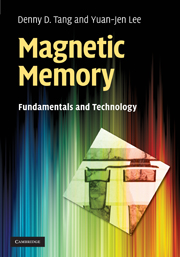Book contents
- Frontmatter
- Contents
- Preface
- Acknowledgments
- 1 Basic electromagnetism
- 2 Magnetic films
- 3 Properties of patterned ferromagnetic films
- 4 Magnetoresistance effects
- 5 Field-write mode MRAMs
- 6 Spin-torque-transfer mode MRAM
- 7 Applications of MTJ-based technology
- Appendix A Unit conversion table for cgs and SI units
- Appendix B Dimensions of units of magnetism
- Appendix C Physical constants
- Appendix D Gaussian distribution and quantile plots
- Appendix E Weibull distribution
- Appendix F Time-dependent dielectric breakdown (TDDB) of magnetic tunnel junction devices
- Appendix G Binomial distribution and Poisson distribution
- Appendix H Defect density and the breakdown/TMR distribution of MTJ devices
- Appendix I Fe, Ni and Co material parameters
- Appendix J Soft error, hard fail and design margin
- Index
Appendix B - Dimensions of units of magnetism
Published online by Cambridge University Press: 06 July 2010
- Frontmatter
- Contents
- Preface
- Acknowledgments
- 1 Basic electromagnetism
- 2 Magnetic films
- 3 Properties of patterned ferromagnetic films
- 4 Magnetoresistance effects
- 5 Field-write mode MRAMs
- 6 Spin-torque-transfer mode MRAM
- 7 Applications of MTJ-based technology
- Appendix A Unit conversion table for cgs and SI units
- Appendix B Dimensions of units of magnetism
- Appendix C Physical constants
- Appendix D Gaussian distribution and quantile plots
- Appendix E Weibull distribution
- Appendix F Time-dependent dielectric breakdown (TDDB) of magnetic tunnel junction devices
- Appendix G Binomial distribution and Poisson distribution
- Appendix H Defect density and the breakdown/TMR distribution of MTJ devices
- Appendix I Fe, Ni and Co material parameters
- Appendix J Soft error, hard fail and design margin
- Index
Summary
SI magnetic units are easily related to the current, voltage and energy in MKS units, since the SI system was originally developed under the assumption that magnetism is originated from electric current. The dimensions of magnetic units are shown below; A = amperes, s = seconds, kg = kilograms and m = meters.
(1) newton (N) = kg m/s2;
(2) joule (J) = kg m2/s2;
(3) magnetic field (H) = A/m;
(4) henry (h) = kg m2/s2A2;
(5) tesla (T) = kg/s2A;
(6) weber (Wb) = kg m2/s2A.
Magnetism in cgs units is less transparent. The unit of magnetic moment m is the emu. The density of the magnetic moment MS is emu/cm3. The magnetic induction is given by B = H + 4πMS, where the magnetic field H is given in units of oersted (Oe) and B is given in gauss (G). (1 Oe = 1 G in air, since M = 0 in air.) Thus, the “4π” in 4πMS is not dimensionless. Its dimension is [G/(emu/cm3)], and it is equivalent to the inverse of susceptibility, so that the unit of 4πMS is [G/(emu/cm3)] · [emu/cm3] = G.
The dimension of “emu” can be understood from the dimension of energy. In Chapter 2, we discussed the magnetostatic energy per unit volume of magnetic material under a magnetic field H to be ∼MS · H. The dimension of MS · H is [emu · cm−3] · [Oe], which should be equivalent to [erg · cm−3]. Therefore, the dimension of emu is [erg/Oe] or [emu/G] in air.
- Type
- Chapter
- Information
- Magnetic MemoryFundamentals and Technology, pp. 177Publisher: Cambridge University PressPrint publication year: 2010

